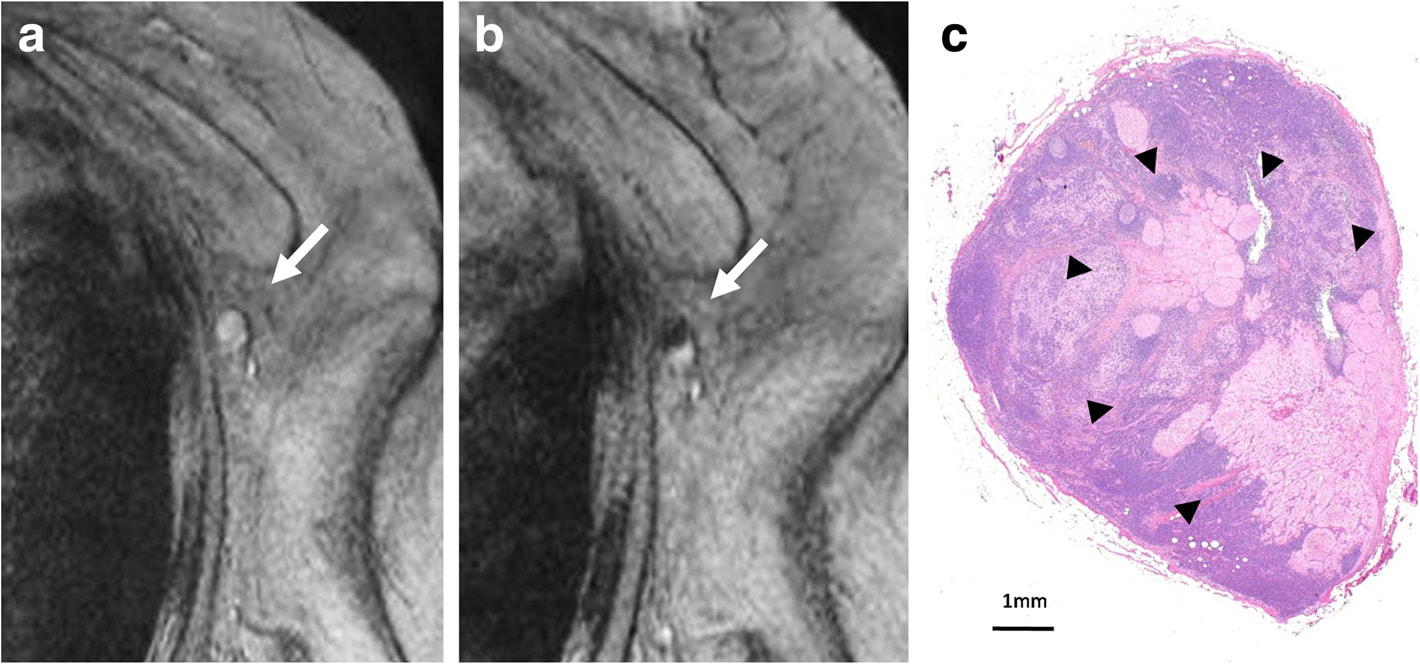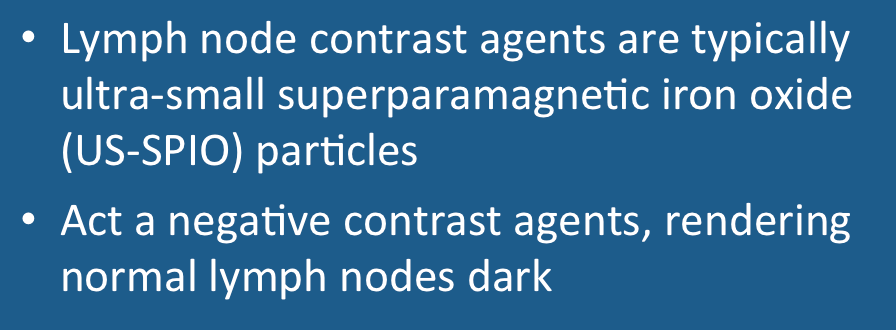Most contrast-enhanced lymph node imaging to date has been performed with ferrite-containing nanoparticles (5-50 nm) known as ultra-small superparamagnetic iron oxides (US-SPIOs or USPIOs). After intravenous injection these nanoparticles are not immediately phagocytized by the liver and spleen, but remain in circulation for several hours. This long blood half-life allows the ultra-small iron agents time to penetrate the vascular endothelium and leak into the interstitium. Thereafter, the particles are cleared by lymphatics, draining into lymph nodes where they are captured and retained by macrophages/histiocytes (and potentially other sinus-lining endothelial cells).
Alternatively the particles may be injected intradermally or subcutaneously, with secondary drainage into lymphatic channels and uptake into regional lymph node chains. This is the MR equivalent of lymphoscintigraphy, a technique commonly used in nuclear medicine for staging cancer and identifying sentinel lymph nodes for surgical sampling.
USPIOs act as negative (susceptibility) contrast agents, reducing signal intensity of normal lymph nodes on T2-weighted images rendering them dark. In theory, lymph nodes containing metastasis will remain bright or show only peripheral darkening. Limited clinical trials of these agents to date, however, have produced mixed results, with concern about high false positive rates for detection of metastases.

Partial replacement of axillary lymph node with breast cancer. (a) On T2WI precontrast image the node (arrow) showed uniform high signal. (b) Post-contrast, the non-cancerous portion of the node accumulated the SPIO and became dark due to T2* effects; the remaining high signal portion represented tumor. (c) Histology confirmed partial replacement of the node by tumor (arrowheads). (From Motomura et al under CC-BY).
The principal commercial USPIO used for lymph node imaging in the 1990s and early 2000s was ferumoxitran-10, marketed as Sinarem®/Combidex®. Like most of the other original iron-oxide nanoparticles, this agent was withdrawn globally for medical use and today is only available in the Netherlands to my knowledge. Fortunately a relatively new USPIO is now widely available, Feraheme™ (ferumoxytol), approved for treatment of iron-deficiency anemia but which can be use "off-label" as a lymphotropic contrast agent in the appropriate clinical scenario. This is the subject of our next Q&A.
Advanced Discussion (show/hide)»
The distinction between small (SPIO) and ultrasmall (USPIO) iron oxide agents is somewhat arbitrary, but the latter usually denotes particles of size less than 50 nm. SPIO's are typically in the 50-200 nm range.
Positive-enhancement lymphotropic contrast agents are also in development using gadolinium with an appropriate chelator. See review by Choi and Moon below for further discussion.
References
Bashir MR, Bhatti L, Marin D, Nelson RC. Emerging applications for ferumoxytol as a contrast agent in MRI. J Magn Reson Imaging 2015; 41:884-898.
Choi SH, Moon WK. Contrast-enhanced MR imaging of lymph nodes in cancer patients. Korean J Radiol 2010; 11:383-394. (review)
Daldrup-Link HE. Ten things you might not know about iron oxide nanoparticles. Radiology 2017; 284:616-629.
Feraheme™ package insert, from www.feraheme.com (assessed 6/19/20)
Harisinghani MG, Barentsz J, Hahn PF, et al. Noninvasive detection of clinically occult lymph-node metastases in prostate cancer. N Engl J Med 2003; 348:2491-9. (early major paper, very remarkable sensitivity and specificity)
Heesakkers RAM, Jager GJ, Hövels AM, et al. Prostate cancer: detection of lymph node metastases outside the routine surgical area with ferumoxtran-10-enhanced MR imaging. Radiology; 2009; 251:408-414. (24% false positive rate in this study, leading to unnecessary surgical intervention).
Motomura K, Tetsuta I, Tateishi S, et al. Correlation between the area of high-signal intensity on SPIO-enhanced MR imaging and the pathologic size of sentinel node metastases in breast cancer patients with positive sentinel nodes. BMC Medical Imaging 2013; 13:32.
Related Questions
Whatever happened to Feridex®? Aren't iron-containing contrast agents useful for liver MRI?
Whatever happened to Feridex®? Aren't iron-containing contrast agents useful for liver MRI?
